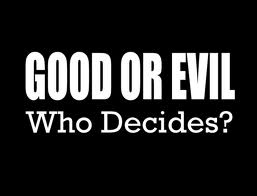Understanding Evil

Three Definitions of a Complicated Word
What is the logical purpose for finding the correct definition of evil? How should evil be defined? Should we define evil using a biblical approach only or should the social ramifications of evil be included to form the most accurate definition of evil? In some respects, confining such a broad term into finite yet comprehensive parameters seems like a daunting task; however, isolating the definition of evil into one that is both meaningful and relative to society at large is extremely useful to the evangelical world.
Why is this act so important to evangelism? The primary reason is to find an answer to understanding the problem of evil that is applicable to all people regardless of race, ethnicity, or cultural attributes is, in effect, a way to finding the way to help individuals understand God’s truth. There are many cultures yet to hear of the grace that comes from a relationship with the one true God, but all cultures have an understanding of evil and how evil actions affect their society’s system of values. Theologically, the problem of evil can not be explained to the world until a relative definition of evil can be understood on a human level.
Looking at the world today, evil seems to run rampant within society. Violent acts on college campuses and in fast-food restaurants are reported daily to a society that seems to cling to images that are too horrible to describe. If researchers took to the streets to conduct a survey related to the meaning of evil, many respondents would relate evil to the violent acts displayed on television and in the pages of Time and Newsweek. Arthur Miller asserts that when people are confronted with evil acts there remains a “central, deadening sense of despair over the human species.”[1] Where is the hope of redemption?
According to Erickson, “We should not set our expectations too high in endeavoring to deal with the problem of evil. This is a very severe problem, perhaps the most severe of all the intellectual problems facing theism.”[2] Yet, man has tried to understand evil for generations. In a social context, evil relates to man’s inhumanity to man. Individuals that are dedicated to the advancement of social thought study evil in order to find the underlying patterns rooted in culture as a means of determining the human processes that maintain and support society. On the flip side, theologians approach the topic of evil in order to define man’s relationship with God and God’s subsequent relationship with man.
In his book, The Psychology of Good and Evil, Holocaust survivor, Ervin Staub states, “The word evil is emotionally expressive for all people.”[3] In other words, mention “evil” and people will react to “evil.” The typical reaction to the word is usually negative and this type of responsiveness indicates that there may be something present within the cognitive being that is able to grasp the concept of an inborn depravity within humanity. Theologically speaking, this inborn malady is the sinful nature passed on to humanity by Adam and Eve. Therefore, this inner knowledge, that may or may not be suppressed by an individual’s cultural belief system, allows the individual to understand God, His love, and the reason for the sacrifice of Jesus Christ at Calvary. The following paper will explore three possible definitions of evil that may assist in the individual understanding of the word evil by looking at the social and theological ramifications of evil upon a fallen society in terms of God’s providence and plan.
Evil as a Destructive Disjuncture
Staub defines evil as “human destructiveness.”[4] Susan L Nelson of Pittsburgh Theological Seminary defines evil as “an awareness of this disjuncture between the pronouncement that life is God’s good creation and the knowledge that suffering and violence are real and threaten not only life and health but also any sense of meaning, order, and blessing.”[5] Therefore, evil can be described as a “destructive disjuncture” or the element that destroys man and his relationship with God.
Evil of this magnitude is common and difficult to comprehend. However, if evil is, in fact, a form of human destructiveness, is it possible for the human race to find a solution to the problem of evil? In his attempt to understand man’s conflict with society Karl Marx yearned for the attainment of a truly human society. Zeitlin states that “Man, Marx believed, is infinitely perfectible. Man’s essential powers—his latent and potential human powers—are unlimited in their capacity for development.”[6] Therefore, man should be able, at some point in time, to reach his full potential. If this statement were true, then man should be able to solve this plague of destructiveness.
However, Cuzzort and King suggest that “It is something of a paradox that we are more capable of dealing with the mysteries of the universe than we are more capable of dealing with ourselves and our social systems. More people probably die each day from problems that come from difficulties in establishing effective economic and social systems than from strictly “natural’ causes.”[7] Therefore, human demise seems to be facilitated by moral evil rather that natural evil. Once again, the presence of a “destructive disjuncture” seems to emerge.
Cuzzort and King’s paradox can only be explained by the existence of sin and the way that sin has affected man’s relationship with God. The first sin committed on that day in the Garden of Eden changed the social make up of history. Darlene Fozard Weaver asserts that “many thinkers, secular and religious, reject the discourse of sin as archaic, dysfunctional, or irrelevant. Sin seems too allied to anachronistic and faithless views of God as wrathful and punitive and to excessively juridical accounts of atonement and salvation.”[8] However, humankind must come to terms with sin in order to reconcile its relationship with the Creator, for discounting the existence of sin only belittles God’s mercy and the suffering of Jesus Christ.
Perfectibility can not be obtained in a world that has been ruined by sin. Suffering exists because of man’s transgressions. In order to understand evil, humankind must evaluate evil in terms of what is considered good. In this moral approach, evil is the element that interrupted perfection; therefore, the acts that stand between man and God must be labeled as “evil.” Thus, a moral code helps man to define evil according to his cognitive reality.
In Genesis 1:31, “God saw all that he had made and it was very good.”[9] Staub points out that “Philosophers like Immanuel Kant and others have proposed universal standards of morality because societies (including small ones like families) can develop cruel, immoral standards of what is acceptable conduct.”[10] Understanding creation in its perfect state helps humanity to see how sin violates God’s original plan for a flawless or “good” creation. Since sin spoiled the” goodness” of creation, evil emerged as a by-product of the punishment. In other words, God had to punish the individual responsible for this action, and, at the same time, God had to develop a plan for man’s salvation.
According to Nelson, “When human suffering conjures up fears that life is meaningless and that there is no good God, the moral view affirms that such evil fits within the purposes of God’s order. Evil functions as punishment for sin, but also to correct the human heart, shatter sinful imaginings, and reorient human beings toward the giver of life.”[11] This definition of evil accomplishes a task that Erickson defines as modifying the concept of God’s goodness.
Evil as Darkness
Why define evil as darkness? Darkness is a common scriptural metaphor for evil. In Luke 11:35, Jesus states “See to it, then, that the light within you is not darkness.”[12] In II Peter 2:17, the apostle proclaims, “These men are springs without water and mists driven by a storm, Blackest darkness is reserved for them.”[13] Therefore, darkness is the evil that separates man from God. At the time of the crucifixion, Matthew describes a period of darkness before the death of Jesus. Humankind had committed the ultimate act of evil—the murder of God’s beloved Son.
It is easy to see why this metaphor is easy for humanity to understand. Oppression, suffering, and states of grief are often described as periods of darkness. At these times, humanity is plunged into a pit of despair and suffering and spiritual anomie. According to Laura Aversano, “Evil was meant to be placed in perspective and respect of the light of God; a necessary means for man understands of truth.”[14] In other words, man must know darkness in order to know light; therefore, man must recognize evil in order to know God.
Nelson states that “Evil cries out for theodicy, for a justification of God’s relationship to evil that allows the sufferer to hope that evil does not have the last word.”[15] The juxtaposition between the light and darkness explains the relationship between God and evil in imagery that people from all walks of life can understand. Therefore, when we hear Jesus called the “light of the world,” we begin to understand that God will use Jesus to overcome the darkness that is in the world. He will use Jesus to overcome evil.
Evil as a Violation of God’s Law
Evil may also be defined as the violation of God’s law. This definition, in some respects, resembles the discussion of evil as a “destructive disjuncture.” However, evil acts that destroy are the direct results of a violation of God’s law. As Staub writes, “The path to grave horror begins with minor transgressions.”[16] There is perhaps no greater horror than the act of genocide. In Rwanda during the 1990s, thousands of people were slain by their friends, neighbors, co-workers and families. This horrible act occurred as a result of building tension between the Hutu and Tutsi ethnic groups in Rwanda. Years of intense jealousy led to Hutus’ slaying their Tutsi neighbors because the Hutu’s hated the privileged Tutsis. We normally do not think that a violation of the tenth commandment could lead to a mass murder, but it did in Rwanda.
People look at Rwanda and Darfur, and think shake there heads in astonishment and disbelief. As Miller states, “Along with despair there may also come a desperate new felling of vulnerability attached to the fact that one is human. If one keeps at the Holocaust long enough, then sooner or later the ultimate personal truth begins to reveal itself: one knows, finally, that one might either do it, or be done to.”[17] The depravity of our sinful nature gives every human the capability of committing acts of unspeakable evil.
Everyone struggles with their own inner battle between good and evil. According to Bill O’Brian, “Christianity and Western civilization do not fight an isolated curse. Other faith systems attempt resolution for the conflict within the human soul. Islam identifies this struggle as jihad. The Arabic root for jihad means ‘strive, effort, labor.” Lesser jihad defines the kind of struggle justified in defense of oneself, for example, in military action. But greater jihad is the fighting of evil in one’s own heart. This is an inward reformation—a spiritual and moral struggle that leads to victory over ego.”[18] Fighting evil within the heart is the human’s attempt at doing the right thing. However, humans in their imperfect state can not clearly see the dividing line between right and wrong. God’s commandments are perhaps the only effective metric that humanity can use to measure good and evil and the blood of Christ is the only way that humanity can atone for the evil that has been done.
Conclusion
Evil exists. This statement mars our human reality. While many have studied the patterns of evil that run rampant in humanity, evil still exists. Man can not eliminate evil for several reasons. The first reason is that man can not achieve perfectibility in his current state. Sin has scarred the human race preventing any attempt at perfectibility. Man must let go of any assumption that humanity has the power to rid the world of evil. The problem of evil exists because man violated God’s law. It is for this reason that humankind must live in the shadow of evil’s darkness.
However, man does not have to live in darkness forever. The light of Jesus can and will overcome the darkness. Calvary conquered evil. Marx believes in the perfectibility of man. The only many with the power to achieve perfectibility was Jesus Christ. It is through Jesus, that all people are made perfect.
Why is understanding evil important to evangelism? The simple answer is that when we understand evil, we understand God’s sovereign power. When we understand evil, we see our need for salvation. In an essay entitled “The Power of the Cross, “ Billy Graham states, “This Gospel of Christ and Him crucified is still foolishness to millions who are perishing all over the world today. How few people recognize that the answer to all the world’s problems can be found at the foot of the cross?[19] The true answer to the problem of evil is found at the cross. It is at the cross of Jesus that our perfectibility is restored. It is here that the world can find the peace that she craves.
REFERENCES
Aversano, Laura. 2004. “Evil and the Light of God.” Journal of Religion & Psychical Research 27, no. 1: 34-36. Academic Search Premier, EBSCOhost (accessed March 4, 2008).
Cuzzort, R. P. & King, Edith W. 1995. Twentieth-Century Social Thought. Fort Worth: HarcourtBraceCollege Publishers.
Erickson, Millard J. 1983. Christian Theology. Grand Rapids: Baker Academic.
Graham, Billy. 2008. “The Power of the Cross” PrayerPoint . Boone: Samaritan’s Purse.
Life Application Study Bible. 1986. Grand Rapids: Zondervan Publishing House
Miller, Authur J. 2004. The Social Psychology of Good and Evil. New York: The Guilford Press.
Nelson, Susan L. 2003. “Facing Evil: Evil’s Many Faces.” Interpretation: A Journal of Bible & Theology 57, no. 4: 398. Academic Search Premier, EBSCOhost (accessed March 4, 2008).
O’Brien, Bill. 2005. “Living by the Word.” Christian Century 122, no. 13: 20-21. Academic Search Premier, EBSCOhost (accessed March 4, 2008).
Staub, Ervin. 2003. The Psychology of Good and Evil: Why Children, Adults, and Groups Help and Harm Others. Cambridge: CambridgeUniversity Press.
Weaver, D. F. 2003. “Taking Sin Seriously.” Journal of Religious Ethics 31, no. 1: 45-74. Academic Search Premier, EBSCOhost (accessed March 4, 2008).
Zeitlin, Irving M. 2001. Ideology and the Development of Sociological Theory. UpperSaddleRiver: Prentice Hall.
[1] Arthur Miller, The Social Psychology of Good and Evil (New York: The Guilford Press, 2004), 1.
[2] Millard J. Erickson, Christian Theology, (Grand Rapids, Baker Academic Press, 1983), 439
[3] Ervin Staub, The Psychology of Good and Evil: Why Children, Adults, and Groups Help and Harm Others, (Cambridge: CambridgeUniversity Press, 2003), 6
[4]Ibid
[5] Susan L. Nelson “Facing Evil’s Many Faces.” Interpretation: A Journal of Bible & Theology, 57 (2003): 398.
[6] Irving M. Zeitlin, Ideology and the Development of Sociological Theory (New Jersey: Prentice Hall, 2001), 140.
[7] R. P. Cuzzort & Edith W. King, Twentieth Century Social Thought, (Forth Worth: Harcourt Brace College Publishers, 1995), 2.
[8] D. F. Weaver, “Taking Sin Seriously.” Journal of Religious Ethics, 31 (2003): 45-74.
[9] Life Application Bible (Grand Rapids: Zondervan Publishing House, 1986)
[10] Ervin Staub, The Psychology of Good and Evil: Why Children, Adults, and Groups Help and Harm Others, (Cambridge: CambridgeUniversity Press, 2003), 6
[11] Susan L. Nelson “Facing Evil’s Many Faces.” Interpretation: A Journal of Bible & Theology, 57 (2003): 398
[12] Life Application Bible (Grand Rapids: Zondervan Publishing House, 1986)
[13] Life Application Bible (Grand Rapids: Zondervan Publishing House, 1986)
[14] Laura Aversano, “Evil and the Light of God.” Journal of Religion & Psychical Research, 27 (2004): 34-36.
[15] Susan L. Nelson “Facing Evil’s Many Faces.” Interpretation: A Journal of Bible & Theology, 57 (2003):398.
[16] Ervin Staub, The Psychology of Good and Evil: Why Children, Adults, and Groups Help and Harm Others, (Cambridge: CambridgeUniversity Press, 2003), 6
[17] Arthur Miller, The Social Psychology of Good and Evil (New York: The Guilford Press, 2004), 1.
[18] Bill O’Brien “Living by the Word.” Christian Century122 (2005): 20-21
[19] Billy Graham “The Power of the Cross” PrayerPoint (2008): 22.









